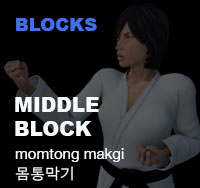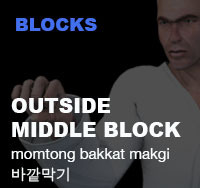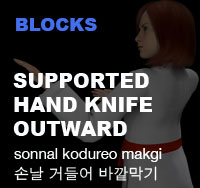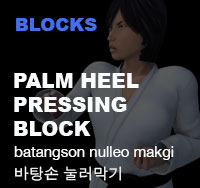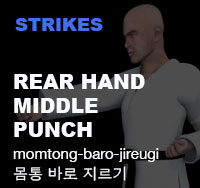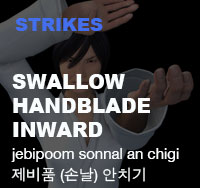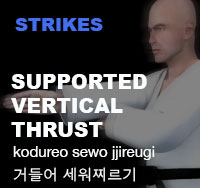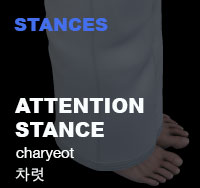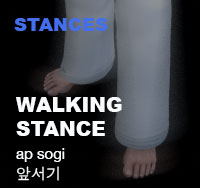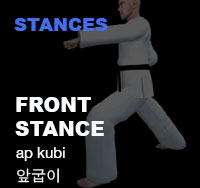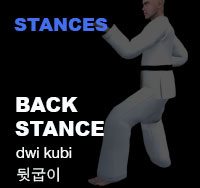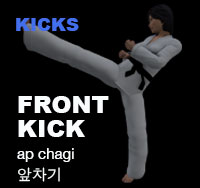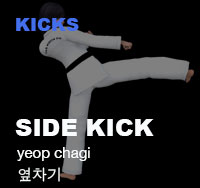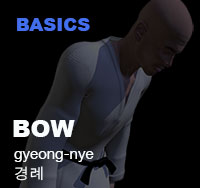- Poomse 품새
- Taegeuk 태극
- Taegeuk #4 Sa Jang
Taekwondo 태권도Taekwondo Preschool
Promotion from one geup to the next can proceed rapidly in some schools, since schools often allow geup promotions every two, three, or four months. Students of geup rank learn the most basic techniques first, and then move on to more advanced techniques as they approach first dan. Many of the older and more traditional schools often take longer to allow students to test for higher ranks than newer, more contemporary schools, as they may not have the required testing intervals. View Taekwondo belt levels »




Taegeuk 4 태극 4장
(Taegeuk Sa-jahng)
Poomse is the foundation for the teaching of Taekwondo. A poomse, or form, is a detailed pattern of defense-and-attack motions and techniques used in traditional martial arts. Poomse is useful in developing proper kinetics, mental and physical fortitude.
Taegeuk 태극 (in World Taekwondo (WT)) refers to a set of poomse used to create a foundation for the teaching of taekwondo. A poomse or form is a detailed pattern of defense-and-attack motions and techniques used in traditional martial arts. Poomse is often romanized as poomsae or pumsae. The word taeguek (the Korean pronunciation of Taiji/T'ai Chi) refers to the important principle in east Asian Taoist thought of the union of yin and yang.
Each taegeuk form symbolizes a specific state thought to be indicative of the belt the student currently holds, and is represented in World Taekwondo (WT) by trigrams similar to those found in the four corners of the South Korean flag. Various schools sometimes insert one of a variety of other forms before the first taegeuk (taegeuk il-jang) such as "Basic #1 Pattern". In order to receive a black belt the student must perform all taegeuk forms consecutively.
Advertisement

Taegeuk 4 태극 4장 (Taegeuk Sa-jahng)
Taegeuk 4 태극 4장 (Taegeuk Sa-jahng)
Korean: 태극 4장 (Taegeuk Sa-jahng)
Meaning: Thunder
Movements: approx 27
Difficulty Level: Intermediate
Grade Level: 6th Geup
Style: World Taekwondo (WT) 
This trigram represents Thunder. Also, the trigram is strongly connected to northeast and the relationship of the Eldest son. Thunder comes from the sky and is absorbed by the earth, thus, according to the beliefs of the I Ching, thunder is one of the most powerful natural forces. This poomse is associated with power and the connection between the heavens and earth. This poomse is intended to be performed with power resembling the Thunder for which it is named.
This is the pattern one will learn when at 'Green Belt' level. All students studying in World Taekwondo (WT) Kukkiwon style must learn these forms, or taegeuk 태극, to advance to a higher belt level. There are eight taegeuk forms, each one similar to the previous one, but each time with more complicated techniques to display the students' mastery of the techniques learned during lessons, as well as the ability to interconnect these techniques. Note: Some schools use other belt colors. Belt levels vary from school to school.
Training Methods
How well one improves with training depends on several factors, such as the frequency it is engaged in, and the type of feedback that is available for improvement. If a student does not train often enough, reinforcement fades, and he or she is likely to forget what was learned for the poomse.
When learning the poomse, it is helpful to use mirrors to observe your techniques and fix your mistakes immediately. Initially, a student may need focused feedback from a certified Master Instructor ( 사범님 sabeomnim ); however, as they progress, they must develop the ability to self-assess the poomse.
Difficulty of Poomse
Taekwondo students of geup ranking learn the most basic techniques first, and then move on to more advanced and difficult techniques as they approach 1st Dan Black Belt. The more difficult the techniques, the more practice may be needed for the purpose of improving or mastering it, as in the phrase 'practice makes perfect'. Every poomse must display the requisite speed, balance, power and firmness to be realistically used as an attack or defense move.
* Please see a certified Master Instructor ( 사범님 sabeomnim ) for training. Proper guidance and instructions are needed to ensure safe training.


Taegeuk 4 태극 4장 (Taegeuk Sa-jahng)
Techniques Included in this Poomse
Both basic and advanced taekwondo techniques can be contained within a single pattern and the higher the level of the practitioner, the greater the difficulty of the techniques and the complexity of the pattern. Remember a poomse is a detailed pattern of defense-and-attack motions and techniques used in traditional martial arts. View more information Poomse »


Taegeuk 4 태극 4장 (Taegeuk Sa-jahng)
Key Points in this Poomse
- Accuracy. Taegeuk 태극 patterns should begin and end in the same place.
- Posture. Practitioners must have their body weight correctly distributed during each different stance ( 서기 sogi ) and during footwork ( 딛기 ditgi ). Each technique must be correctly aligned.
- Realism. Taekwondo patterns are the learning ground for real combat. As such, every technique must display the requisite speed, power and firmness to be realistically used as an attack or defense move.
- Spirit. A competitor's 'presence' on the mat must be as credible as his/her technique. Self belief, confidence in abilities, and intention to perform to a personal best are tangible virtues considered indispensable in taekwondo practitioners.
- Decorum. Proper manners must be displayed when interacting with the judges directly before and after the pattern. Respect must also be extended to rival competitors, clubs and other officials.
- Form. General qualities that judges look for in any taekwondo practitioner include proper breathing technique and body control. The diaphragm must be engaged in deep breathing, shallow breathing concentrated in the upper abdomen results in raised shoulders and stressed muscles. The muscles of the body should be lightly relaxed in order to perform the pattern with fluidity, speed and grace. Muscles should only be tensed at the moment of imaginary impact in order to commute maximum power to any individual taekwondo technique.
Promotion Tests Requirement
Students often undergo periodic testing and grading by their own Master Instructor ( 사범님 sabeomnim ) in order to advance to a higher level of recognized achievement such as a different belt color. They need to demonstrate their proficiency in the various aspects of the art such as the execution of patterns ( 품새 poomse ), which combine various techniques in specific sequences.
Taegeuk 4 태극 4장 (Taegeuk Sa-jahng) is a requirement for the below belt levels (Varies between schools). Promotion from one belt level to the next can proceed rapidly in some schools, since schools often allow geup promotions every two, three, or four months. Students of geup rank learn the most basic techniques first, and then move on to more advanced techniques as they approach first dan black belt. View Promotion Tests »
Use in Demonstrations
To promote taekwondo for its emphasis on high kicking and fast hand techniques, taekwondo schools perform at tournaments, community events, shopping malls, parks, and tv shows. Demonstrations vary from school to school, but may include such elements as the execution of poomse ( 품새 poomse ), which combine various techniques in specific sequences; the breaking of boards to demonstrate the ability to use techniques with both power and control; sparring ( 겨루기 gyeorugi ) and self-defense ( 호신술 hosinsool ) to demonstrate the practical application and control of techniques; physical fitness usually with push-ups and sit-ups. For more information on Demonstrations »
( Click image for additional information)


Did you know?
Impact Surface Area
Various surfaces of the body may be engaged as the blocking and striking surface depending on which area of the body is being targeted. This leads to a large array of blocking and striking positions. More information on Impact Surface Areas »
| Surface | Korean | Description | Tutorial | |
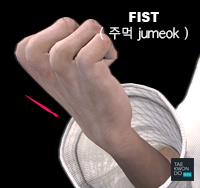 |
Fist ( 주먹 jumeok ) - is an action where a hand has the fingers curled into the palm and the thumb retracted, displaying the knuckles. |
주먹 jumeok | A fist ( 주먹 jumeok ) is an action where a hand has the fingers curled into the palm and the thumb retracted, displaying the knuckles. The act of creating a fist is known as 'making a fist' or 'clenching a fist'. | Tutorial » |
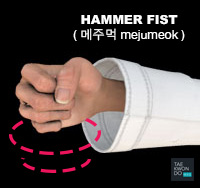 |
Hammer Fist ( 메주먹 mejumeok ) - is an action where a hand has the fingers curled into the palm and the thumb retracted, using the bottom of the hand as the striking surface. |
메주먹 mejumeok | A Hammer Fist is an action where a hand has the fingers curled into the palm and the thumb retracted, using the bottom of the hand as the striking surface. The act of creating a fist ( 주먹 jumeok ) is known as 'making a fist' or 'clenching a fist'. | Tutorial » |
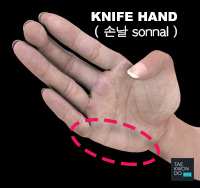 |
Hand Blade ( 손날 sonnal ) - striking surface extends with the muscle at the side of the hand located between the base of the small finger and the wrist. |
손날 sonnal | By tucking the thumb into the palm, a striking surface called the knife hand or hand blade ( 손날 sonnal ) is formed. The striking surface extends with the muscle at the side of the hand located between the base of the small finger and the wrist. | Tutorial » |
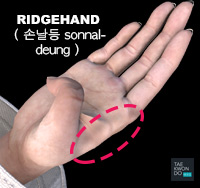 |
Ridgehand ( 손날등 sonnal-deung ) - reverse knife-hand is formed, extending a few inches along the inside of the hand below the first knuckle of the index finger. |
손날등 sonnal-deung | By tucking the thumb into the palm, a striking surface called the ridgehand ( 손날등 sonnal-deung ), or reverse knife-hand is formed, extending a few inches along the inside of the hand below the first knuckle of the index finger. | Tutorial » |
RESOURCES
This article uses material from the Wikipedia articles "Hand", "Fist (hand)", "Knife Hand", which is released under the Creative Commons Attribution-Share-Alike License 3.0.
Advertisement
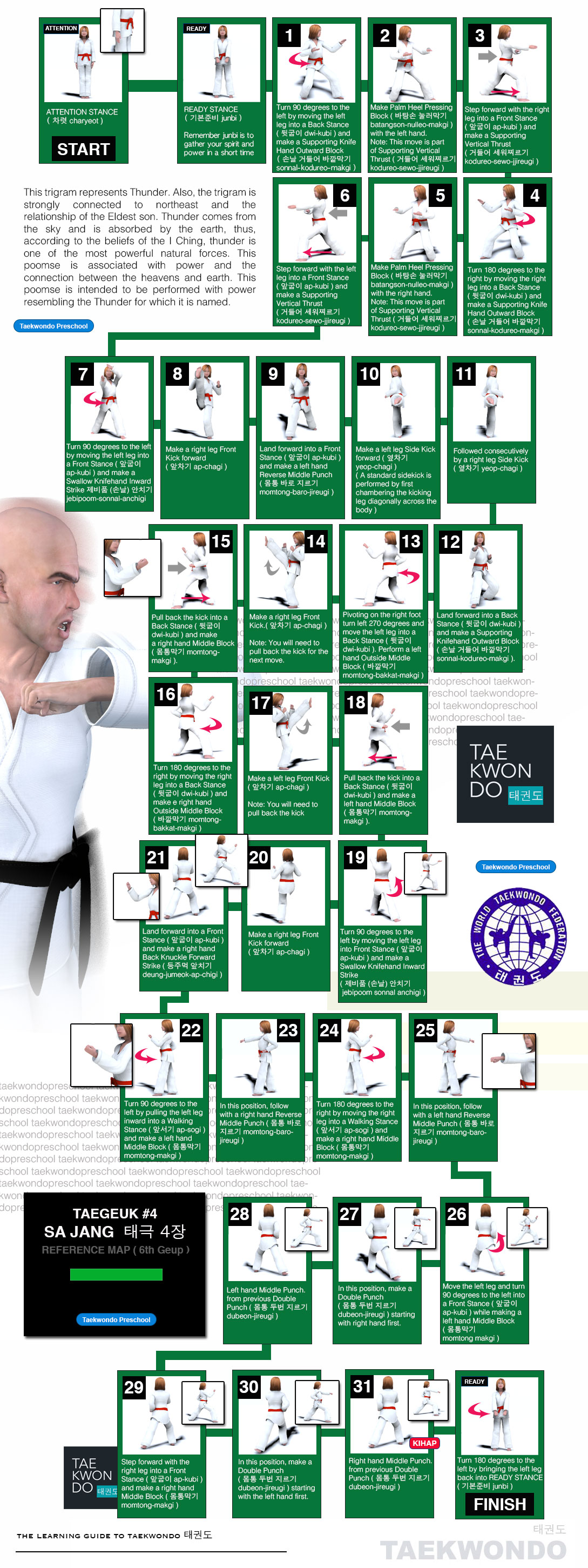
Advertisement

Quiz
Question. What is the korean terminology for Single Knife Hand Outward Block?
The Single Knife Hand Outward Block is an intermediate blocking technique. The hand is kept in a knife hand posture to block ( 막기 makgi ) attacks to the torso. As the front arm sweeps across in an arc from the inside to the outside of the body, the back hand is simultaneously pulled back to the back hip and ready for a counter-attack such as a punch ( 지르기 jireugi ) to the opponent.
Question. What is the korean terminology for Single Knife Hand Outward Block?
Answer you gave was: ( 가위막기 kawi makgi )
Your answer is wrong! You need to study more!
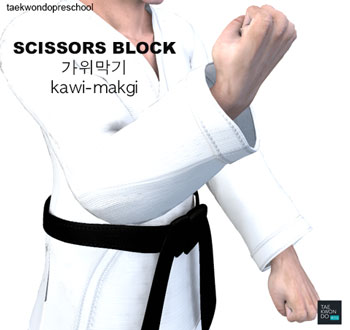
Scissors Block ( 가위막기 kawi-makgi ) is an advanced technique to combination block ( 막기 makgi ) at the same time with a Low Block ( 아래막기 arae makgi ) and an Inner Wrist Outer Block ( 안팔목 바깥막기 anpalmok momtong bakkat magki ). Blocking fists are parallel to the shoulder to keep the defense tight and the palm ( 손바닥 sonbadak ) of the fists should face the body.
Question. What is the korean terminology for Single Knife Hand Outward Block?
Answer you gave was: ( 산틀막기 santeul makgi )
Your answer is wrong! You need to study more!
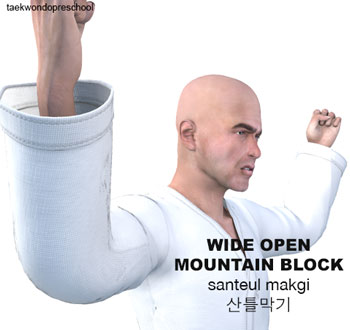
The Wide Open Mountain Block ( 산틀막기 santeul-makgi ) is an advanced technique performed in the 2nd Dan Black Belt poomse Keumgang. Depending on the direction of the block, both hands are swung to the back side of the head twisting the torso in the same direction, while you then quickly twist the other direction stomping on the ground and blocking simultaneously.
Question. What is the korean terminology for Single Knife Hand Outward Block?
Answer you gave was: ( 한손날 바깥막기 hansonnal bakkat makgi )
Your answer is correct! Great Job!
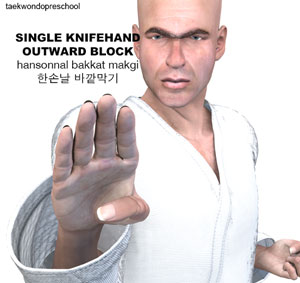
The hand ( 손 son ) is kept in a knife hand ( 손날 sonnal ) posture to block ( 막기 makgi ) attacks to the torso. As the front arm sweeps across in an arc from the inside to the outside of the body, the back hand is simultaneously pulled back to the back hip and ready for a counter-attack such as a punch ( 지르기 jireugi ) to the opponent.
View Single Knife Hand Outward Block ( 한손날 바깥막기 hansonnal bakkat makgi ) »
Question. What is the korean terminology for Single Knife Hand Outward Block?
Answer you gave was: ( 올려막기 olgul makgi )
Your answer is wrong! You need to study more!

The High Block ( 올려막기 olgul-makgi ) deflects a downward strike such as a Hammer Fist Downward Strike ( 메주먹 내려치기 mejumeok-naeryeo-chigi ), a stick attack from above, a face punch from a taller opponent, or possibly a kick like the Axe Kick ( 내려차기 naeryeo-chagi ). The blocking arm starts low with the hand in a relaxed fist ( 주먹 jumeok ) across the abdomen (over the belt) with the palm ( 손바닥 sonbadak ) facing upward.
Question. What is the korean terminology for Back Stance?
Back stance is specifically focused on shifting weight to the back leg, as it offers much more control, and makes it easier to kick off the front leg. To perform this stance, the body faces to the side, with the front foot facing forward and the front leg bent. The back leg is bent slightly and the foot is turned outwards perpendicular to the front foot making the letter "L" for this stance.
Question. What is the korean terminology for Back Stance?
Answer you gave was: ( 뒷굽이 dwi kubi )
Your answer is correct! Great Job!

Back Stance ( 뒷굽이 dwi kubi ) is specifically focused on shifting weight to the back leg, as it offers much more control, and makes it easier to kick off the front leg. To perform the Back Stance ( 뒷굽이 dwi-kubi ), the body faces to the side, with the front foot facing forward and the front leg bent. The back leg is bent slightly and the foot is turned outwards perpendicular to the front foot making the letter "L" for this stance ( 서기 sogi ).
Question. What is the korean terminology for Back Stance?
Answer you gave was: ( 주춤서기 juchum sogi )
Your answer is wrong! You need to study more!

The Horse-Riding Stance ( 주춤서기 juchum-sogi ) is a beginner stance ( 서기 sogi ) generally used to practice punches ( 지르기 jireugi ) and blocks ( 막기 makgi ). It is similar to the Ready Stance ( 기본준비 junbi ) but the feet are placed much wider, about two-foot length's apart. Also, the knees ( 무릎 mureup ) are deeply bent and the shins ( 정강이 jeonggangi ) should be kept slightly perpendicular to the floor.
Question. What is the korean terminology for Back Stance?
Answer you gave was: ( 앞굽이 ap kubi )
Your answer is wrong! You need to study more!

Front Stance ( 앞굽이 ap-kubi ) is one of the most important techniques to learn when starting taekwondo as a beginner. The distance between the inside edges or namely the Reverse Foot Blade ( 발날등 balnaldeung ) of both feet should be between one to two fists apart and is about 4 to 4 one-half foot-length from origin. Rear toes are turned outward about 30 degrees and the body is also naturally angled at 30 degrees or facing straight forward depending on the upper body technique.
Question. What is the korean terminology for Back Stance?
Answer you gave was: ( 앞서기 ap sogi )
Your answer is wrong! You need to study more!

The Walking Stance ( 앞서기 ap-sogi ) is a beginner stance ( 서기 sogi ) that is used to approach or retreat in combat and patterns ( 품새 poomse ). Feet should be maintained approximately 3 foot-length from origin. To maintain a solid base, the front foot is facing straight forward and the back foot is 30 degrees to aid balance. Use of this stance ( 서기 sogi ) is featured prominently in many of the World Taekwondo (WT) Poomse.
Question. What is the korean terminology for Palm Heel Pressing Block?
Palm Heel Pressing Block is a standard block ( 막기 makgi ) used to deflect incoming kicks ( 차기 chagi ) and punches ( 지르기 jireugi ). Open the hand ( 손 son ) and use the 'bottom of the palm' or ‘palm heel’ to block the trunk area. The open hand is raised up to shoulder height and thrust directly down to meet the attackers hand or limb.
Question. What is the korean terminology for Palm Heel Pressing Block?
Answer you gave was: ( 올려막기 olgul makgi )
Your answer is wrong! You need to study more!

The High Block ( 올려막기 olgul-makgi ) deflects a downward strike such as a Hammer Fist Downward Strike ( 메주먹 내려치기 mejumeok-naeryeo-chigi ), a stick attack from above, a face punch from a taller opponent, or possibly a kick like the Axe Kick ( 내려차기 naeryeo-chagi ). The blocking arm starts low with the hand in a relaxed fist ( 주먹 jumeok ) across the abdomen (over the belt) with the palm ( 손바닥 sonbadak ) facing upward.
Question. What is the korean terminology for Palm Heel Pressing Block?
Answer you gave was: ( 안팔목 바깥막기 anpalmok bakkat makgi )
Your answer is wrong! You need to study more!
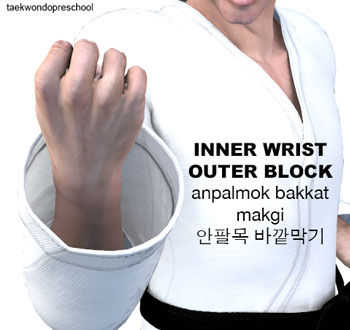
The Inner Wrist Outer Block ( 안팔목 바깥막기 anpalmok-bakkat-makgi ) uses the inner wrist ( 안팔목 anpalmok ) of your forearm to deflect a strike away from your body. The blocking fist is parallel to the shoulder and the palm of the fist should face the body. The other hand should have the wrist stick to the waist of the body to prepare for counter-attack after a successful block.
View Inner Wrist Outer Block ( 안팔목 바깥막기 anpalmok bakkat makgi ) »
Question. What is the korean terminology for Palm Heel Pressing Block?
Answer you gave was: ( 몸통막기 momtong makgi )
Your answer is wrong! You need to study more!

An inside Middle Block ( 몸통막기 momtong-makgi ) deflects a strike away from the defender and away from the attacker. For example, against a straight punch ( 지르기 jireugi ) to the face, an inside forearm block would aim to meet the inside of the forearm of the attacker, pushing the punch ( 지르기 jireugi ) outward, leaving the opponent open for a counter attack.
Question. What is the korean terminology for Palm Heel Pressing Block?
Answer you gave was: ( 바탕손 눌러막기 batangson nulleo makgi )
Your answer is correct! Great Job!

Palm Heel Pressing Block is a standard block used to deflect incoming kicks and punches. Open the hand ( 손 son ) and use the 'bottom of the palm' ( 바탕손 batangson ) to block the trunk area. The open hand is raised up to shoulder height and thrust directly down to meet the attackers hand or limb.
The heel of the hand ( 바탕손 batangson ) makes contact with the attacker’s forearm in case of a punch ( 지르기 jireugi ), or the shin ( 정강이 jeonggangi ) in case of a kick ( 차기 chagi ). Although simple, it requires a lot of partner training to get the timing of this taekwondo block ( 막기 makgi ) correct.
View Palm Heel Pressing Block ( 바탕손 눌러막기 batangson nulleo makgi ) »
Did you know? Taekwondo Preschool Master Edition Available Now
Taekwondo Preschool Master Edition


The book Taekwondo Preschool Master Edition provides in-depth information on the explosive and powerful techniques of taekwondo. There are lots of illustrations and interactive content within the master edition guidebook with over 1500+ pages. Are you prepared to learn the Korean Martial Arts! The book is available for download with Apple Books on your Mac or iOS device, and with iTunes on your computer. Books can be read with Apple Books on your Mac or iOS device.
View more information about the book »
- Taekwondo Stances ( 서기 sogi )
- Taekwondo Blocking ( 막기 makgi )
- Taekwondo Kicking ( 차기 chagi )
- Taekwondo Fist Strikes ( 지르기 jireugi )
- Taekwondo Strikes ( 치기 chigi )
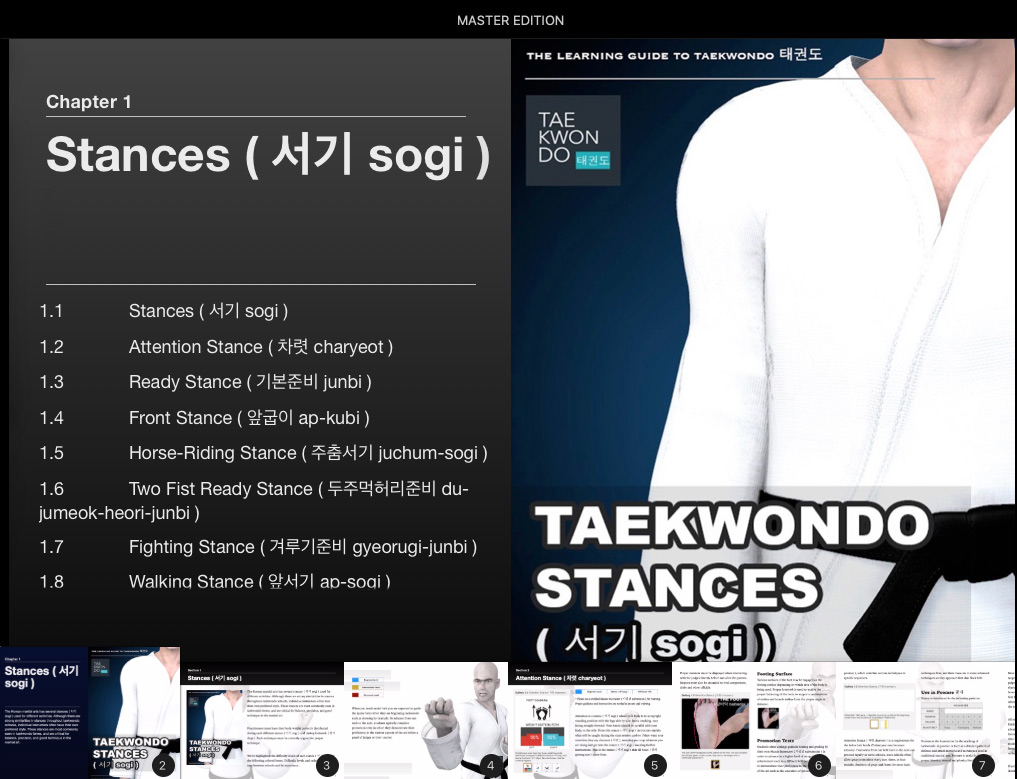
Taekwondo Preschool Master Edition

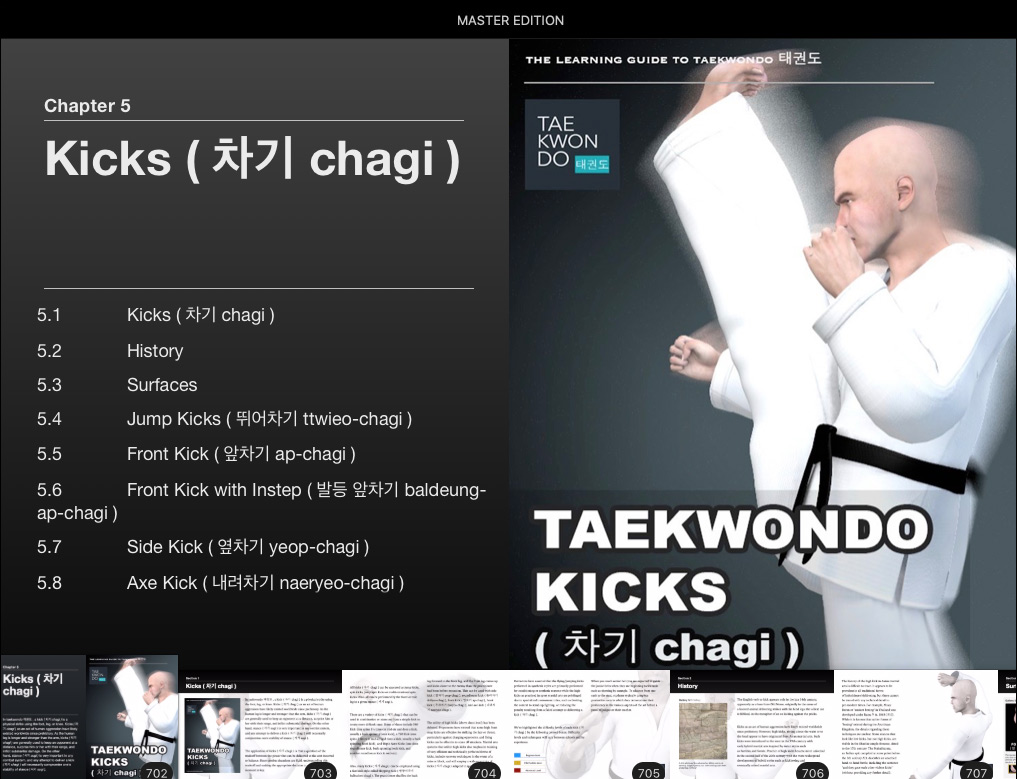
Taekwondo Preschool Master Edition

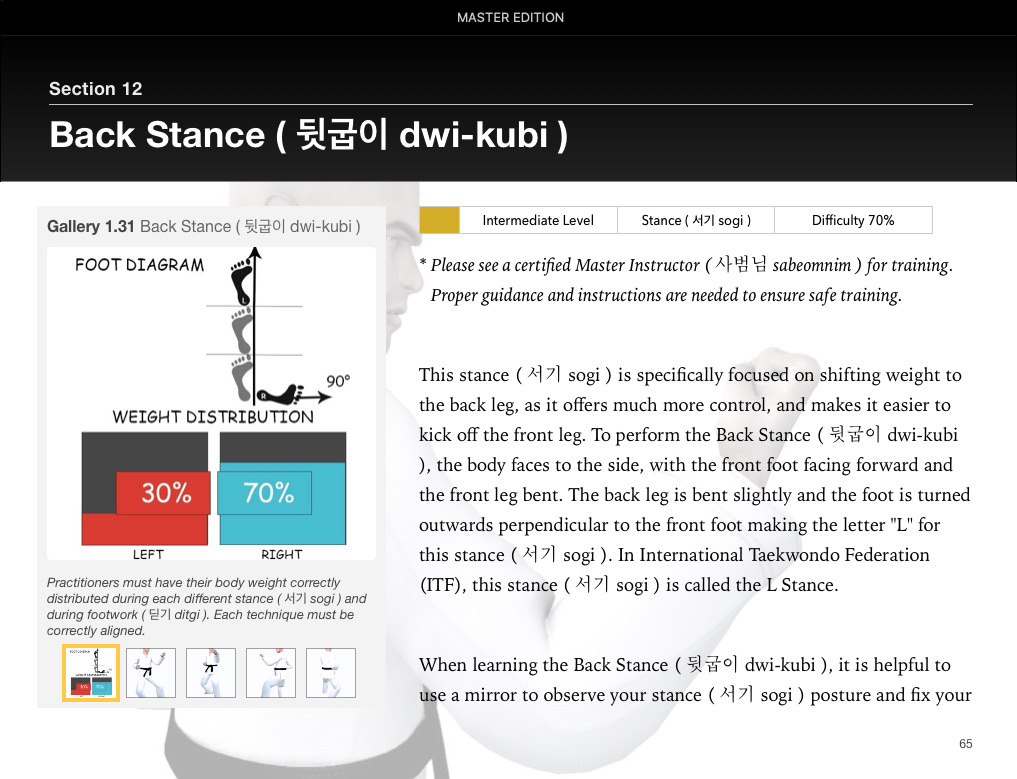
Taekwondo Preschool Master Edition
Sample: The Back Stance ( 뒷굽이 dwi-kubi ) is specifically focused on shifting weight to the back leg, as it offers much more control, and makes it easier to kick off the front leg


Taekwondo Preschool Master Edition
Sample: The Keumgang Punch ( 금강지르기 keumgang-jireugi ) is an advanced technique that requires you to punch ( 지르기 jireugi ) and block upwards ( 올려막기 olgul makgi ) at the same time

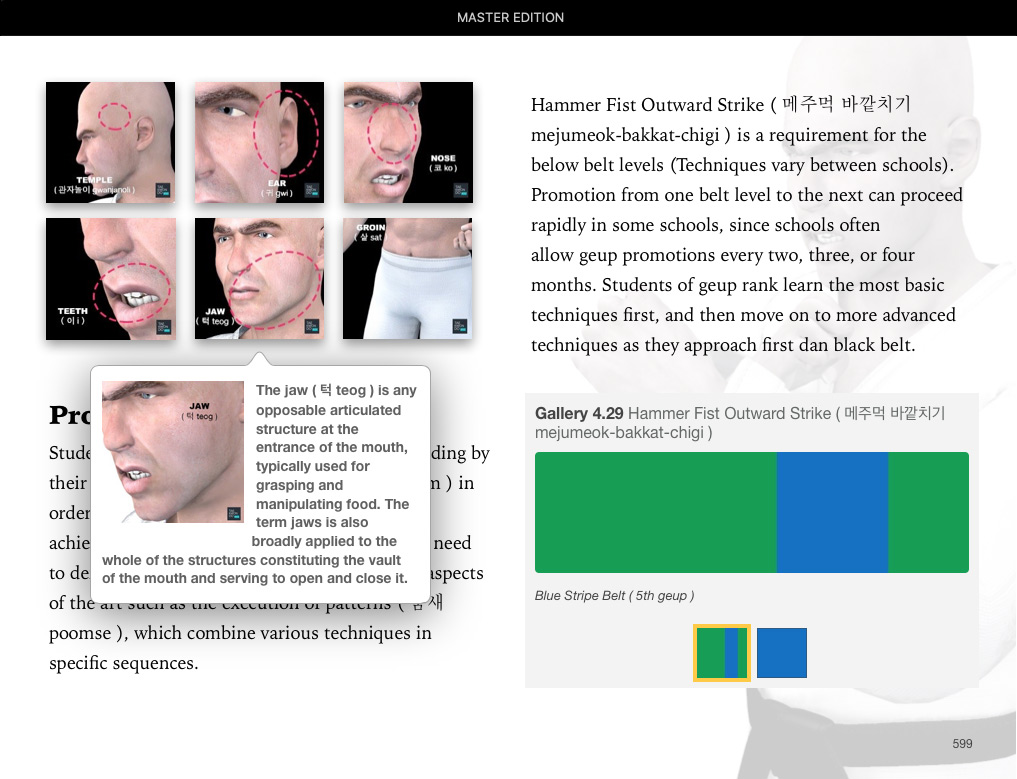
Taekwondo Preschool Master Edition
Sample: Hammer Fist Outward Strike ( 메주먹 바깥치기 mejumeok-bakkat-chigi ) is an intermediate strike that is delivered by hitting the opponent's chest to the upper area of the face with the closed fist sideways at full velocity

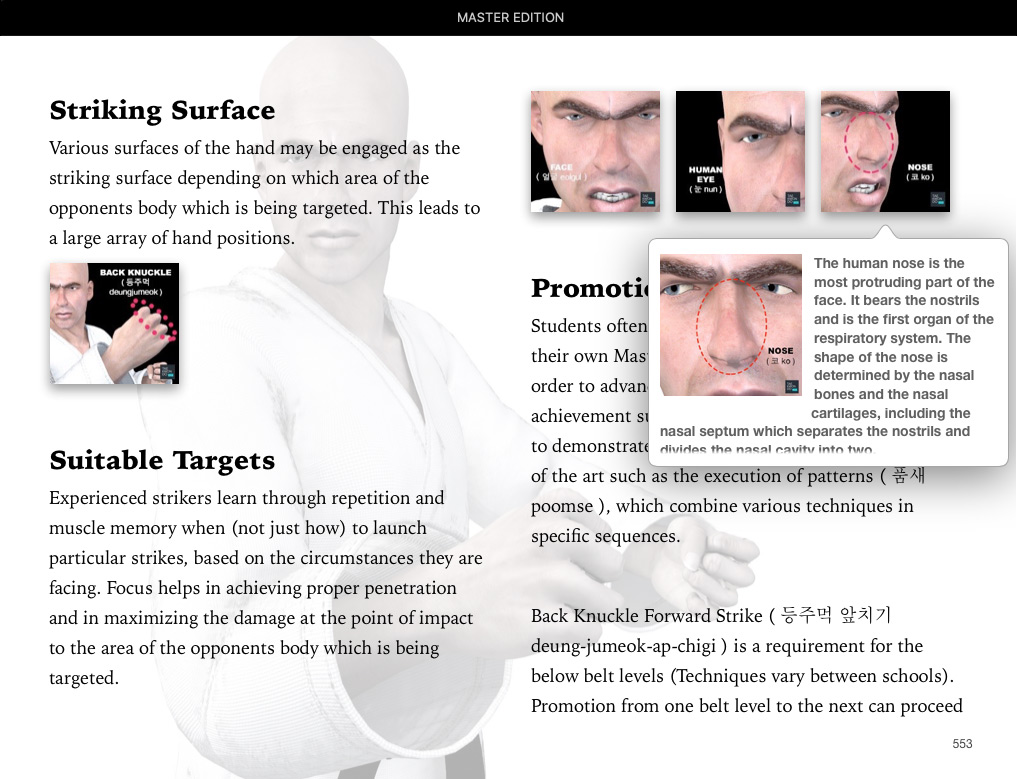
Taekwondo Preschool Master Edition
Sample: Back Knuckle Forward Strike ( 등주먹 앞치기 deung-jumeok-ap-chigi ) should pass over from the opposite waist to the armpit, to the chin level and then hitting with the back of the fist to the opponent's face


Taekwondo Preschool Master Edition
Sample: Knife Hand Inward Strike ( 손날 안치기 sonnal-an-chigi ) is an intermediate technique that is executed by striking with the muscle at the side of the hand located between the base of the small finger and the wrist

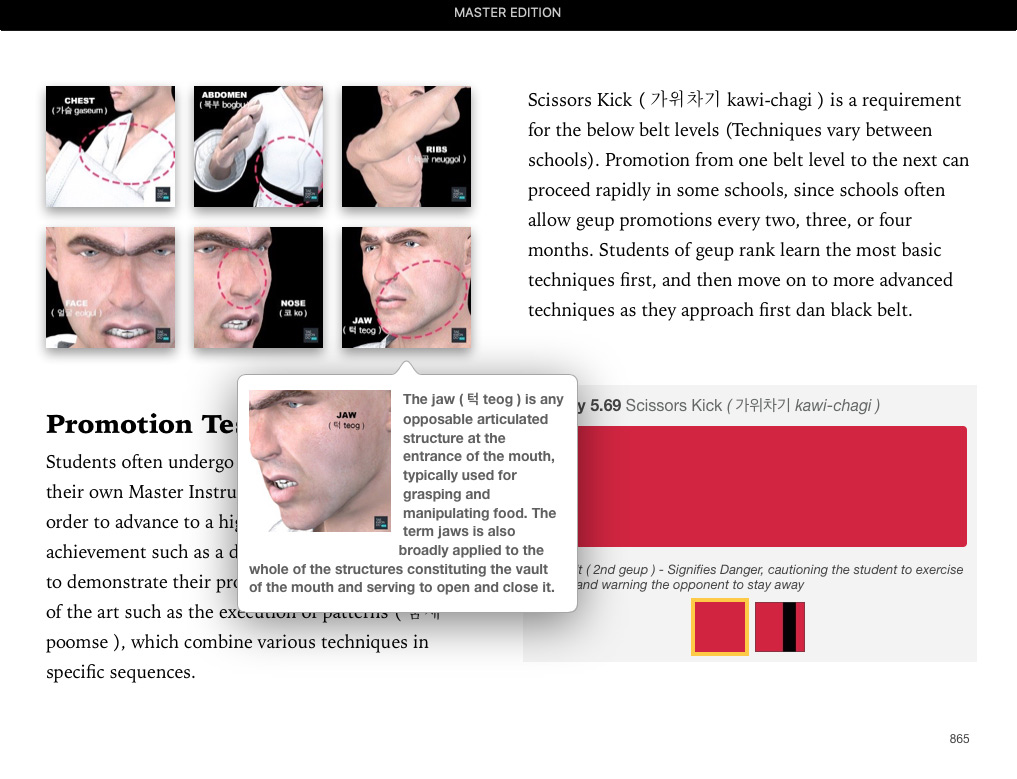
Taekwondo Preschool Master Edition
Sample: The Scissors Kick ( 가위차기 kawi-chagi ) is delivered while in the air moving forward into two opponents simultaneously after a running start to gain forward momentum

( Click image for additional information)


Taegeuk 태극 Poomse
Taegeuk 태극 (in World Taekwondo (WT)  ) refers to a set of poomse 품새 used to create a foundation for the teaching of taekwondo. A poomse or form (represented by 形 or 型) is a detailed pattern of defense-and-attack motions and techniques used in traditional martial arts. The word taeguek refers to the important principle in east Asian Taoist thought of the union of yin and yang. Each taegeuk form symbolizes a specific state thought to be indicative of the belt the student currently holds, and is represented in World Taekwondo (WT) by trigrams similar to those found in the four corners of the South Korean flag. View more information about Taegeuk 태극 Poomse ».
) refers to a set of poomse 품새 used to create a foundation for the teaching of taekwondo. A poomse or form (represented by 形 or 型) is a detailed pattern of defense-and-attack motions and techniques used in traditional martial arts. The word taeguek refers to the important principle in east Asian Taoist thought of the union of yin and yang. Each taegeuk form symbolizes a specific state thought to be indicative of the belt the student currently holds, and is represented in World Taekwondo (WT) by trigrams similar to those found in the four corners of the South Korean flag. View more information about Taegeuk 태극 Poomse ».
General qualities that judges look for in any taekwondo practitioner include proper breathing technique and body control. The diaphragm must be engaged in deep breathing, shallow breathing concentrated in the upper abdomen results in raised shoulders and stressed muscles. The muscles of the body should be lightly relaxed in order to perform the pattern with fluidity, speed and grace. Muscles should only be tensed at the moment of imaginary impact in order to commute maximum power to any individual taekwondo technique. For more information View Key Points »
RESOURCES
This article uses material from the Wikipedia articles "Taegeuk" and "Hyeong", which is released under the Creative Commons Attribution-Share-Alike License 3.0.


